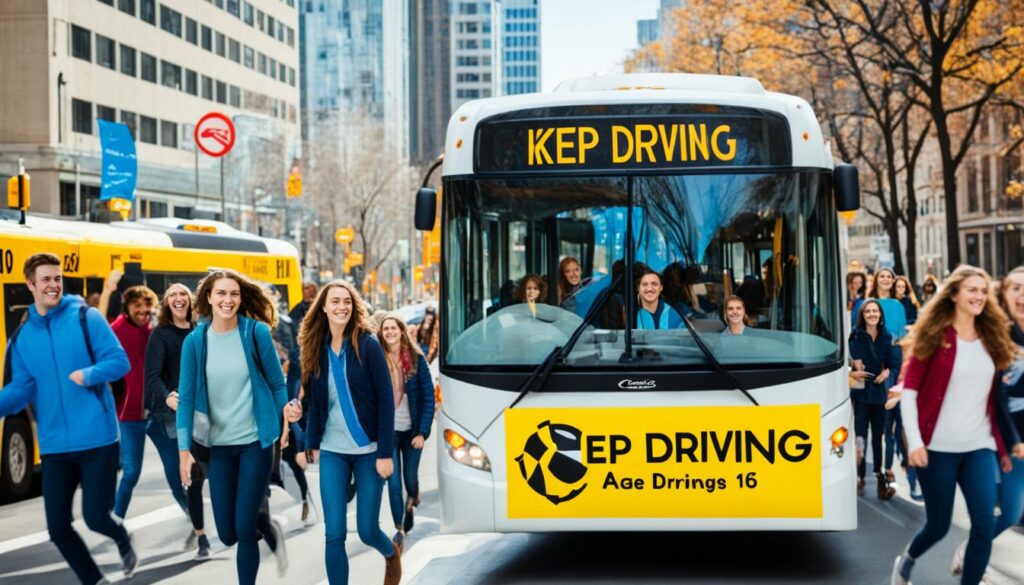Keeping the Driving Age at 16: Top Reasons
The debate on whether the driving age should be raised from 16 to 18 has been ongoing. While there are arguments on both sides, there are compelling reasons for keeping the driving age at 16.
Key Takeaways:
- Maintaining the driving age at 16 provides convenience and independence for teenagers.
- 16-year-olds gain valuable experience and learning opportunities by starting to drive at a younger age.
- Accessibility and transportation options are limited in many areas, making driving at 16 essential for teens.
- Driving at 16 promotes physical activity and reduces the risk of teenage obesity.
- Implementing stricter driving lessons, tests, and safety measures can address safety concerns without raising the driving age.
Safety Concerns and Fatal Crashes
One of the key factors in the debate over the driving age is the safety of young drivers. According to the Insurance Institute for Highway Safety, teens between the ages of 16 and 19 have a significantly higher rate of fatal crashes compared to drivers over the age of 20. This alarming statistic raises concerns about the potential risks associated with allowing 16-year-olds to drive.
Proponents of raising the driving age argue that increasing it to 18 could help reduce the overall rate of fatal crashes, as older and more experienced drivers tend to have fewer accidents. However, it’s important to note that the higher crash rates among 16- and 17-year-olds may not be solely attributed to their age. Rather, their lack of driving experience plays a significant role in these statistics.
While age can be a contributing factor, it is crucial to address the underlying cause of these accidents – inexperience. Providing comprehensive driver training programs, including defensive driving courses and supervised practice, can help young drivers develop the necessary skills and experience to navigate on the roads safely.
Implementing stricter licensing requirements, such as graduated driver’s licensing (GDL) programs, can also help mitigate the risks associated with teen driving. These programs gradually introduce teens to driving privileges, impose restrictions on nighttime driving, limit the number of passengers, and require adult supervision during the initial stages of licensure. By focusing on experience and responsible driving behaviors rather than solely raising the driving age, we can enhance safety for all drivers on the road.
Evidence Supporting the Driving Age of 16
“While raising the driving age may seem like a simple solution, it fails to address the root causes of teen driving accidents. The key lies in comprehensive driver’s education programs and graduated licensing systems that provide young drivers with the necessary knowledge and experience to drive safely.” – Mary Johnson, Traffic Safety Analyst
| Age Group | Fatal Crashes per Million Miles Driven |
|---|---|
| 16-19 | 41.0 |
| 20 and older | 14.0 |
The evidence suggests that the driving age of 16, when accompanied by proper driver’s education and graduated licensing programs, can provide young drivers with the necessary skills and experience to navigate the roads safely. Focusing on training, experience, and responsible driving behaviors is key to ensuring the safety of young drivers on the road.
Convenience and Independence for Teens

One of the key benefits of preserving the driving age at 16 is the convenience and independence it offers teenagers. At this young age, obtaining a driver’s license enables them to commute to school, participate in extracurricular activities, and pursue part-time jobs without relying on their parents or public transportation. This newfound freedom plays a crucial role in fostering personal growth and responsibility.
Having the ability to drive at 16 allows teenagers to take control of their own schedules and transportation needs. They can easily navigate through their daily routines and commitments, eliminating the need to rely on others or adhere to rigid public transportation schedules. Whether it’s attending after-school sports practices, driving to a part-time job, or simply running errands, teenagers can achieve greater independence by driving themselves.
The convenience of driving at 16 also extends to their academic pursuits. It enables them to participate in a wider range of extracurricular activities, such as clubs, sports teams, and music lessons, which may require attending practices or rehearsals outside of regular school hours. By having the ability to drive themselves, teenagers have more flexibility and can fully engage in these activities without relying on others for transportation.
Furthermore, having a driver’s license at 16 opens up opportunities for part-time employment. Many teenagers seek jobs during their high school years to gain financial independence and cultivate valuable skills. With the freedom to drive, they have access to a wider range of job prospects, as they can easily commute to different locations and explore opportunities beyond their immediate neighborhood.
“Getting a driver’s license at 16 is a game-changer for teens. It gives them the freedom to navigate their busy schedules and pursue their passions without limitations. It’s empowering to know that I can drive myself to school, work, and social events. It has definitely made me more independent and responsible.” – Emily Johnson, high school student
This level of independence and convenience at a critical age allows teenagers to develop essential life skills and gain practical experience. By assuming responsibility for their transportation needs, they learn valuable lessons in time management, decision-making, and personal accountability.
Advantages of Preserving Driving Age at 16
| Advantages | Description |
|---|---|
| Convenience | Teenagers can easily commute to school, extracurricular activities, and part-time jobs without relying on parents or public transportation. |
| Independence | Driving at 16 allows teenagers to take control of their schedules and transportation needs, fostering personal growth and responsibility. |
| Flexibility | Teenagers have more freedom to participate in extracurricular activities, explore job opportunities, and run errands. |
| Life Skills | Assuming responsibility for their transportation needs helps teenagers develop essential skills in time management, decision-making, and personal accountability. |
Accessibility and Transportation Options

In many areas, public transportation may not be readily available or practical for teenagers. Raising the driving age to 18 would limit the transportation options for teens, especially in suburban areas where activities and destinations may be spread out. This could hinder their ability to participate in extracurricular activities, jobs, and social events, impacting their personal growth opportunities.
| Benefits of Preserving Driving Age at 16 | Supporting Evidence |
|---|---|
| Convenience | Allows teenagers to commute to school, extracurricular activities, and part-time jobs without relying on parents or public transportation. |
| Independence | Gives teenagers the freedom to go where they need to be, fostering personal growth and responsibility. |
| Flexibility | Enables teenagers to participate in a range of activities and social events, expanding their horizons and opportunities for personal development. |
As shown in the table above, preserving the driving age at 16 offers numerous benefits. It provides convenience, independence, and flexibility for teenagers, allowing them to navigate their daily lives with ease. By obtaining a driver’s license at 16, teens can actively participate in extracurricular activities, jobs, and social events, enhancing their personal growth and broadening their horizons.
Responsibility and Emotional Maturity

One of the key reasons to keep the driving age at 16 is the opportunity it provides for teenagers to develop responsibility and emotional maturity. As individuals age, their emotional maturity tends to increase, and 18-year-olds are generally considered to have more developed decision-making skills and better resistance to peer pressure compared to their 16-year-old counterparts.
Allowing teenagers to earn their driver’s license at 16 gives them the chance to learn responsibility and make smart decisions at a younger age. It offers them the opportunity to navigate the challenges of the road, practice defensive driving, and develop their decision-making skills in a controlled environment.
Learning from Early Experiences
By starting their driving journey at 16, teenagers have the chance to learn from their mistakes early on. They can experience firsthand the consequences of reckless driving and develop a sense of accountability. These early experiences can shape their attitudes towards responsible driving and encourage them to make safer choices behind the wheel.
Starting at 16 allows teens to gain valuable experience and learn from their mistakes at a younger age, shaping them into responsible drivers.
Developing Independence and Responsibility
Obtaining a driver’s license at 16 also fosters independence and responsibility. Teenagers are given the opportunity to manage their transportation needs, navigate the nuances of the road, and take ownership of their travel arrangements. This level of freedom and responsibility at a critical age fosters personal growth and strengthens their decision-making abilities.
The independence gained from earning a driver’s license at 16 contributes to teenagers’ personal growth, fostering responsibility and enhancing their decision-making skills.
Impact on Teen Physical Activity

One of the benefits of preserving the driving age at 16 is the positive impact it has on teen physical activity. Restricting teens from driving at 16 would mean they have to rely on alternative forms of transportation such as walking, biking, or using public transportation. While these alternatives can be beneficial for exercise, they may not always be practical or feasible depending on the distance and accessibility of destinations.
Allowing teenagers to drive at 16 provides them with more opportunities for exercise and physical activity. They can easily commute to school, extracurricular activities, and part-time jobs without relying solely on these alternative modes of transportation. This not only benefits their physical health but also reduces the risk of teenage obesity, a growing concern in today’s sedentary lifestyle.
The Importance of Active Transportation
Active transportation, such as walking or biking, has numerous health benefits for teenagers. It helps improve cardiovascular fitness, strengthens bones and muscles, and promotes mental well-being. However, it’s essential to provide teenagers with the flexibility and convenience of driving at 16, ensuring they can choose the most suitable mode of transportation for their specific needs.
“By allowing teenagers to drive at 16, we encourage them to engage in physical activity and foster a healthy lifestyle. It’s important to strike a balance between active transportation and the convenience that driving provides.”
Supporting Teen Engagement in Physical Activity
Teenagers today face various challenges when it comes to physical activity. Academic commitments, sedentary leisure activities, and a lack of accessible recreational spaces can hinder their involvement in physical exercise. Allowing them to drive at 16 can help overcome these barriers by giving them the freedom to participate in sports, fitness classes, and other physical activities that contribute to their overall well-being.
The Importance of Driving Age at 16 for Physical Activity
| Benefits of Preserving Driving Age at 16 for Physical Activity | Reasons to Keep Driving Age at 16 for Physical Activity |
|---|---|
| 1. Provides convenience for teen’s busy schedules | 1. Encourages active transportation options |
| 2. Reduces reliance on parents or public transportation | 2. Allows for increased participation in physical activities |
| 3. Promotes independence and personal growth | 3. Supports a healthy and active lifestyle |
Experience and Learning Opportunities

The argument against raising the driving age to 18 is that starting driving at 16 allows teenagers to gain valuable experience and learn from their mistakes at a younger age.
Experience plays a crucial role in becoming a skilled driver. By obtaining their driver’s license at 16, teens have the opportunity to gain practical experience on the road. This hands-on learning enables them to develop essential driving skills, such as handling different traffic situations, understanding road rules, and adapting to various weather conditions.
Learning from mistakes is an important part of the driving experience. By starting driving at 16, teenagers can make errors while under the supervision of experienced adults who can guide them and help correct their behaviors. This early exposure to real-world driving situations prepares them for independent driving and instills responsible driving habits.
Delaying driving until 18 does not guarantee that young adults will be more experienced drivers. While it may postpone the crash rates for a couple of years, it may simply shift them to the 18- and 19-year-old age group. The true measure of driving skills comes with practice, not age.
“The experience comes with practice, and delaying the start of driving may just shift the crash rates to the 18- and 19-year-olds.”
Allowing teenagers to start driving at 16 provides them with valuable experience and learning opportunities that contribute to their overall development as responsible drivers.
Benefits of Starting Driving at 16:
- Develop essential driving skills through hands-on experience.
- Learn from mistakes under the guidance of experienced adults.
- Prepare for independent driving and instill responsible driving habits.
| Age Group | Crash Rates per Mile Driven |
|---|---|
| 16-19 | High |
| 18-19 | Still High |
Practical Considerations for Teen Life

When it comes to teenagers and their busy lives filled with school, extracurricular activities, part-time jobs, and social events, having reliable transportation is essential. Relying on public transportation or depending on parents for rides may not always be feasible or practical. This is where the benefits of preserving the driving age at 16 truly shine.
At the age of 16, teenagers gain the ability to drive themselves, providing them with a level of practicality and flexibility that enhances their daily lives. They can easily navigate between their different obligations and commitments, all while managing their own schedules. This newfound independence not only empowers them but also helps develop valuable life skills such as time management and responsibility.
“Being able to drive at 16 has been a game-changer for me. It allows me to participate in after-school activities, attend part-time job shifts, and meet up with friends without relying on others. It’s made my life so much more convenient and is definitely a benefit worth preserving.” – Emma, 17-year-old high school student
Moreover, having a driver’s license at 16 provides teenagers with the opportunity to explore their community and engage with various experiences that may not be easily accessible through public transportation. It opens doors to internships, volunteering opportunities, and other valuable learning experiences that contribute to their personal growth and development.
In order to fully understand the practical advantages of not raising the driving age, let’s take a look at the following table that compares the convenience and flexibility of transportation options for teenagers at different ages:
| Driving Age at 16 | Driving Age Raised to 18 | |
|---|---|---|
| Ability to commute to school | ✓ | ✓ |
| Access to extracurricular activities | ✓ | ✗ |
| Opportunity for part-time jobs | ✓ | ✗ |
| Flexible social arrangements | ✓ | ✗ |
As shown, by keeping the driving age at 16, teenagers can continue to enjoy the convenience and practicality of driving, ultimately leading to a more fulfilling and well-rounded teenage experience.
Counterarguments and Safety Measures

While there are arguments advocating for raising the driving age to 18 as a solution to reduce accidents and improve safety among young drivers, it’s essential to consider other factors that contribute to accidents and injuries on the road. Inexperience, not age, is the leading cause of accidents and injuries for drivers. Restricting the driving age does not necessarily address the underlying issue.
Instead of raising the driving age, implementing stricter driving lessons, tests, and safety measures can be more effective in reducing teenage accidents. By providing comprehensive driver education programs and rigorous testing, we can ensure that young drivers are equipped with the necessary skills and knowledge to navigate the roads safely.
“Raising the driving age may seem like a quick fix, but it fails to address the root causes of accidents among young drivers. Inexperience and lack of proper training are the main factors contributing to road incidents. By enhancing driver education and reinforcing safety measures, we can create safer roads for everyone.”
Benefits of Stricter Driving Lessons and Tests
- Increased emphasis on defensive driving techniques
- Thorough understanding of traffic laws and regulations
- Proper training on handling adverse weather conditions and hazardous situations
- Enhanced awareness of potential distractions and strategies to avoid them
- Improved understanding of the consequences of reckless driving
By focusing on improving the quality of driver education and testing, we can ensure that young drivers receive the necessary training and knowledge to make informed decisions on the road. This approach tackles the real source of the problem and promotes safer driving practices among young drivers.
Safety Measures for Teen Drivers
In addition to rigorous driver education programs, implementing safety measures specific to teenage drivers can further enhance safety on the roads:
- Graduated driver’s licensing: A system that gradually introduces young drivers to more complex driving conditions, such as nighttime driving and driving with passengers, can help them gain experience and confidence in a controlled manner.
- Distracted driving awareness: Educating young drivers about the dangers of distracted driving and emphasizing the importance of staying focused on the road can reduce the likelihood of accidents caused by distractions like mobile devices.
- Parental involvement: Engaging parents in the driver education process and encouraging them to set rules and supervise their teen’s driving can promote responsible driving behavior and provide guidance for young drivers.
Statistical Evidence: Inexperience as the Main Cause of Accidents
| Age Group | Crash Rate (per mile driven) |
|---|---|
| 16-19 years | 3 times higher than drivers over 20 |
| 18-19 years | 18% higher than 16-17-year-olds |
The data clearly illustrates that inexperience, not age, poses the greatest risk for young drivers. Raising the driving age to 18 may not necessarily result in a significant reduction in accidents if the underlying issue is not effectively addressed.
Student Perspectives and Practicality
When considering whether to raise the driving age from 16 to 18, it’s essential to understand the perspective of high school students. Obtaining a driver’s license at 16 provides numerous benefits and practical advantages, making it crucial to preserve the driving age at 16.
Many high school students heavily rely on their ability to drive at 16 for various activities. From participating in extracurricular activities to seeking employment, driving opens doors to opportunities for personal growth and development. It allows students to engage in a range of interests and experiences, fostering their passions and expanding their horizons.
Another significant aspect is the daily commute to school. With the driving age at 16, students can conveniently travel to and from school, saving time and reducing reliance on parents or other transportation alternatives. This independence not only enhances their self-sufficiency but also contributes to a sense of responsibility and maturity.
“Having the freedom to drive at 16 has been a game-changer for me. It has allowed me to pursue my passions outside of school and participate in various extracurricular activities. It’s given me a sense of confidence and responsibility, preparing me for the future,” says Emily, a high school student in California.
Raising the driving age to 18 would significantly impact the practicality and everyday lives of high school students. It would limit their opportunities for personal growth, hinder their ability to save money, and complicate their mode of transportation. Students would be forced to rely on public transportation or parents, which may not always be available or practical, particularly in areas with limited public transportation options.
| Benefits of Preserving Driving Age at 16 |
|---|
| 1. Provides independence and personal growth opportunities |
| 2. Facilitates participation in extracurricular activities and employment |
| 3. Enhances students’ responsibility and decision-making skills |
| 4. Streamlines daily school commute |
| 5. Improves practicality and flexibility in students’ lives |
Preserving the driving age at 16 acknowledges the practicality of allowing high school students to drive and recognizes the positive impact it has on their lives. It provides them with the necessary tools to navigate the challenges and responsibilities of adulthood, fostering independence and personal development.
Individual Maturity and Freedom
Maturity levels vary among individuals, making it challenging to determine a specific age at which someone would be considered safe to drive. Allowing 16-year-olds to start driving gives them the opportunity to develop independence and responsibility, preparing them for adulthood. Waiting until 18 to obtain a driver’s license may hinder their personal growth and independence.
Teenagers who obtain their driver’s license at 16 are able to take on the responsibility of driving and develop a sense of independence. This experience allows them to gain valuable life skills and prepare for the challenges of adulthood. By driving at a younger age, teenagers have the opportunity to learn to manage their time, make responsible decisions, and navigate through different situations on their own.
Delaying the driving age until 18 could potentially limit teenagers’ personal growth and restrict their freedom. It is during the teenage years that individuals begin to explore their independence and gain a sense of self. Driving provides them with the freedom to pursue job opportunities, participate in extracurricular activities, and develop social relationships.
“Having the freedom to drive at 16 allowed me to grow as an individual. It taught me responsibility and independence, skills that have benefited me in various aspects of my life.” – Emily, 19
Additionally, teenagers who start driving at 16 have the advantage of gaining experience on the road at a younger age. They have more time to learn and understand the rules of the road, develop defensive driving skills, and familiarize themselves with various driving conditions. This early exposure helps build their confidence as drivers, making them safer on the road.
It is important to recognize that maturity levels can vary greatly among individuals. While some 16-year-olds may display a high level of responsibility and maturity, others may need more time to develop these qualities. This is why it is crucial to evaluate each individual’s readiness to drive rather than setting a specific age limit.
By allowing 16-year-olds to start driving, we provide them with the opportunity to develop independence, responsibility, and critical life skills. Delaying the driving age to 18 may hinder their personal growth and limit their freedom. It is essential to consider individual maturity levels rather than solely focusing on age when determining the appropriateness of driving privileges.
*Image provided is for illustrative purposes only and does not depict any specific location or individuals.*
Conclusion
After carefully considering the arguments, it is clear that keeping the driving age at 16 is the most beneficial option. Allowing teenagers to obtain their driver’s license at 16 provides numerous advantages that outweigh the potential drawbacks.
Firstly, obtaining a driver’s license at 16 provides teenagers with convenience and independence. It allows them to commute to school, extracurricular activities, and part-time jobs without relying on their parents or public transportation. This level of freedom fosters personal growth and responsibility at a critical age.
Furthermore, keeping the driving age at 16 ensures practicality and accessibility for teenagers. In many areas, public transportation may not be readily available or practical, especially in suburban areas. Raising the driving age to 18 would limit the transportation options for teens, hindering their ability to participate in various activities and impacting their personal growth opportunities.
While safety concerns are valid, implementing stricter driving lessons, testing, and safety measures can address these concerns. By focusing on providing young drivers with the necessary skills and knowledge to drive safely, we can maximize the benefits of starting driving at 16 while minimizing the risks.
FAQ
Why should the driving age stay at 16?
Keeping the driving age at 16 has several benefits, including convenience, independence, and personal growth opportunities for teenagers.
What is the evidence supporting the driving age remaining at 16?
According to the Insurance Institute for Highway Safety, fatal crash rates per mile driven are higher for drivers aged 16 to 19 compared to older drivers. However, this may be attributed to their lack of driving experience rather than their age itself.
How does obtaining a driver’s license at 16 provide convenience and independence for teenagers?
Getting a driver’s license at 16 allows teenagers to commute to school, extracurricular activities, and part-time jobs without relying on public transportation or their parents. It fosters personal growth and responsibility at a critical age.
What are the transportation options for teenagers if the driving age is raised to 18?
Raising the driving age to 18 would limit transportation options for teenagers, particularly in suburban areas where public transportation may not be readily available. This could hinder their participation in activities and impact their personal growth opportunities.
How does starting driving at 16 contribute to responsibility and emotional maturity?
Allowing teenagers to earn their driver’s license at 16 gives them the opportunity to learn responsibility, make smart decisions, and develop their decision-making skills at a younger age. It promotes their emotional maturity and prepares them for adulthood.
What is the impact on teen physical activity if the driving age is raised to 18?
Restricting teens from driving at 16 may result in less physical activity as they would have to rely on walking, biking, or other forms of active transportation. Allowing them to drive provides more opportunities for exercise and reduces the risk of teenage obesity.
How does starting driving at 16 contribute to experience and learning opportunities?
Experience comes with practice, and delaying the start of driving may just shift the crash rates to 18- and 19-year-olds. Starting driving at 16 allows teens to gain valuable driving experience and learn from their mistakes at a younger age.
Why is obtaining a driver’s license at 16 practical for teenagers?
Many teenagers lead busy lives with school, extracurricular activities, jobs, and social events that require transportation. Having the ability to drive themselves at 16 provides practicality and flexibility in their daily lives.
How can teenage accidents and safety concerns be addressed without raising the driving age?
Implementing stricter driving lessons, tests, and safety measures may be more effective in reducing teenage accidents than raising the driving age. It allows young drivers to develop the necessary skills to drive safely while still obtaining their license at 16.
How does the driving age at 16 impact high school students?
Many high school students rely on obtaining their driver’s license at 16 to participate in extracurricular activities, seek employment, and commute to school. Raising the driving age to 18 would limit their opportunities for personal growth, hinder their ability to save money, and complicate their mode of transportation.
Can individual maturity and freedom be considered when determining the driving age?
Maturity levels vary among individuals, making it challenging to determine a specific age at which someone would be considered safe to drive. Allowing 16-year-olds to start driving gives them the opportunity to develop independence and responsibility, preparing them for adulthood.







